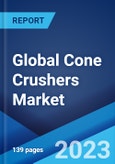The global cone crushers market size reached US$ 1.68 Billion in 2022. Looking forward, the market is expected to reach US$ 2.25 Billion by 2028, exhibiting a growth rate (CAGR) of 5.0% during 2022-2028.
A cone crusher is a mechanical device used to reduce the size of large rocks. It is widely used in the construction and mining industries to crush hard and abrasive materials, such as river gravel, basalt, granite, iron, chrome, magnesite, and copper ores. Nowadays, several manufacturers are offering variants made using high-grade steel in robust designs. They provide the optimum strength and stability required to crush extra-hard materials while ensuring low maintenance costs.
A cone crusher is a mechanical device used to reduce the size of large rocks. It is widely used in the construction and mining industries to crush hard and abrasive materials, such as river gravel, basalt, granite, iron, chrome, magnesite, and copper ores. Nowadays, several manufacturers are offering variants made using high-grade steel in robust designs. They provide the optimum strength and stability required to crush extra-hard materials while ensuring low maintenance costs.
Cone Crushers Market Trends
Rising investments in infrastructure development, in confluence with a significant increase in the number of commercial construction activities, represents one of the primary factors bolstering the market growth. Moreover, the emerging automation trend in mining operations is positively influencing the demand for cone crushers with hydraulic clamping to increase power, production, and output. Furthermore, due to rising environmental concerns and stringent government policies, several organizations are focusing on lowering costs and improving the energy consumption of equipment. This is driving the adoption of cone crushers worldwide in the recycling and reuse of bitumen and aggregates as new asphalt. Apart from this, cone crushers generally involve high operating costs for the maintenance of wear components. As a result, market players are introducing liner profiling systems that offer an improved prediction of the mantle and concave liner replacement, identify asymmetric and high wear areas, measure open and closed-side settings and calculate the wear life of cone crushers. They are also launching connected variants with built-in computer intelligence and automation and connectivity systems (ACS). As these crushers allow operators to predict performance, maximize uptime, and provide sustainability, their demand is anticipated to rise in the coming years.Key Market Segmentation
This research provides an analysis of the key trends in each sub-segment of the global cone crushers market report, along with forecasts at the global, regional and country level from 2023-2028. The report has categorized the market based on type, offering, power source and application.Breakup by Type:
- Symons
- Hydraulics
- Gyratory
Breakup by Offering:
- Mobile Crushers
- Portable Crushers
- Stationary Crushers
Breakup by Power Source:
- Electric Connection
- Diesel Connection
- Dual Connection
Breakup by Application:
- Mining and Metallurgy
- Construction
- Aggregate
- Demolition
- Environmental
Breakup by Region:
- North America
- United States
- Canada
- Asia-Pacific
- China
- Japan
- India
- South Korea
- Australia
- Indonesia
- Europe
- Germany
- France
- United Kingdom
- Italy
- Spain
- Russia
- Latin America
- Brazil
- Mexico
- Middle East and Africa
Competitive Landscape
The competitive landscape of the industry has also been examined along with the profiles of the key players being Astec Industries Inc., FLSmidth & Co. A/S, Keestrack, McCloskey International Limited (Neles Oyj), Puzzolana, Sandvik AB, Terex Corporation, Tesab Engineering Ltd, thyssenkrupp AG and Westpro Machinery Inc.Key Questions Answered in This Report:
- How has the global cone crushers market performed so far and how will it perform in the coming years?
- What has been the impact of COVID-19 on the global cone crushers market?
- What are the key regional markets?
- What is the breakup of the market based on the type?
- What is the breakup of the market based on the offering?
- What is the breakup of the market based on the power source?
- What is the breakup of the market based on the application?
- What are the various stages in the value chain of the industry?
- What are the key driving factors and challenges in the industry?
- What is the structure of the global cone crushers market and who are the key players?
- What is the degree of competition in the industry?
Table of Contents
1 Preface3 Executive Summary12 Value Chain Analysis14 Price Analysis
2 Scope and Methodology
4 Introduction
5 Global Cone Crushers Market
6 Market Breakup by Type
7 Market Breakup by Offering
8 Market Breakup by Power Source
9 Market Breakup by Application
10 Market Breakup by Region
11 SWOT Analysis
13 Porters Five Forces Analysis
15 Competitive Landscape
Companies Mentioned
- Astec Industries Inc.
- FLSmidth & Co. A/S
- Keestrack
- McCloskey International Limited (Neles Oyj)
- Puzzolana
- Sandvik AB
- Terex Corporation
- Tesab Engineering Ltd
- thyssenkrupp AG
- Westpro Machinery Inc.
Methodology

LOADING...
Table Information
| Report Attribute | Details |
|---|---|
| No. of Pages | 139 |
| Published | November 2023 |
| Forecast Period | 2022 - 2028 |
| Estimated Market Value ( USD | $ 1.68 Billion |
| Forecasted Market Value ( USD | $ 2.25 Billion |
| Compound Annual Growth Rate | 5.0% |
| Regions Covered | Global |
| No. of Companies Mentioned | 10 |









